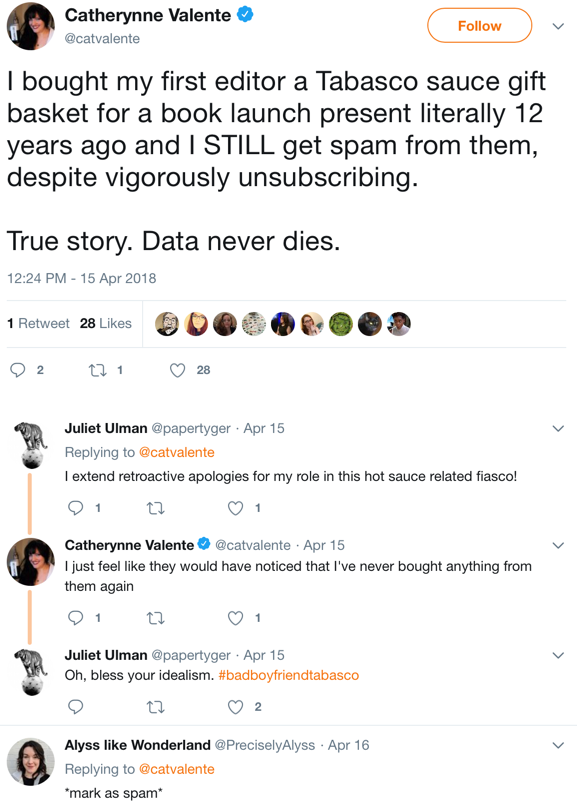Related Posts
Would you buy a used car from that guy?
- laura
- Oct 20, 2010
There are dozens of people and companies standing up and offering suggestions on best practices in email marketing. Unfortunately, many of those companies don’t actually practice what they preach in managing their own email accounts.
I got email today to an old work email address of mine from Strongmail. To be fair it was a technically correct email. Everything one would expect from a company handling large volumes of emails. It’s clear that time and energy was put into the technical setup of the send. If only they had put even half that effort into deciding who to send the email to. Sadly, they didn’t.
My first thought, upon receiving the mail, was that some new, eager employee bought a very old and crufty list somewhere. Because Strongmail has a reputation for being responsible mailers, I sent them a copy of the email to abuse@. I figured they’d want to know that they had a new sales / marketing person who was doing some bad stuff.
I know how frustrating handling abuse@ can be, so I try to be short and sweet in my complaints. For this one, I simply said, “Someone at Strongmail has appended, harvested or otherwise acquired an old email address of mine. This has been added to your mailing list and I’m now receiving spam from you. ”
They respond with an email that starts with:
“Thank you for your thoughtful response to our opt-in request. On occasion, we provide members of our database with the opportunity to opt-in to receive email marketing communications from us.”
Wait. What? Members of our database? How did this address get into your database?
“I can’t be sure from our records but it looks like someone from StrongMail reached out to you several years ago. It’s helpful that you let us know to unsubscribe you. Thank you again.”
There you have it. According to the person answering email at abuse@ Strongmail they sent me a message because they had sent mail to me in the past. Is that really what you did? Send mail to very old email addresses because someone, at some point in the past, sent mail to that address? And you don’t know when, don’t know where the address came from, don’t know how it was acquired, but decided to reach out to me?
How many bad practices can you mix into a single send, Strongmail? Sending mail to addresses where you don’t know how you got them? Sending mail to addresses that you got at least 6 years ago? Sending mail to addresses that were never opted-in to any of your mail? And when people point out, gently and subtly, that maybe this is a bad idea, you just add them to your global suppression list?
Oh. Wait. I know what you’re going to tell me. All of your bad practices don’t count because this was an ‘opt-in’ request. People who didn’t want the mail didn’t have to do anything, therefore there is no reason not to spam them! They ignore it and they are dropped from your list. Except it doesn’t work that way. Double opt-in requests to someone has asked to be subscribed or is an active customer or prospect is one thing. Requests sent to addresses of unknown provenance are still spam.
Just for the record, I have a good idea of where they got my address. Many years ago Strongmail approached Word to the Wise to explore a potential partnership. We would work with and through Strongmail to provide delivery consulting and best practices advice for their customers. As part of this process we did exchange business cards with a number of Strongmail employees. I suspect those cards were left in a desk when the employees moved on. Whoever got that desk, or cleaned it out, found those cards and added them to the ‘member database.’
But wait! It gets even better. Strongmail was sending me this mail, so that they could get permission to send me email about Email and Social Media Marketing Best Practices. I’m almost tempted to sign up to provide me unending blog fodder for my new series entitled “Don’t do this!”
August 2015: The month in review
- laura
- Sep 2, 2015
It’s been a busy blogging month and we’ve all written about challenges and best practices. I found myself advocating that any company that does email marketing really must have a well-defined delivery strategy. Email is such vital part of how most companies communicate with customers and potential customers, and the delivery landscape continues to increase in complexity (see my post on pattern matching for a more abstract look at how people tend to think about filters and getting to the inbox). Successful email marketers are proactive about delivery strategy and are able to respond quickly as issues arise. Stay tuned for more from us on this topic.
I also wrote up some deliverability advice for the DNC, which I think is valuable for anyone looking at how to maintain engagement with a list over time. It’s also worth thinking about in the context of how to re-engage a list that may have been stagnant for a while. A comment on that post inspired a followup discussion about how delivery decisions get made, and whether an individual person in the process could impact something like an election through these delivery decisions. What do you think?
As we frequently point out, “best practices” in delivery evolve over time, and all too often, companies set up mail programs and never go back to check that things continue to run properly. We talked about how to check your tech, as well as what to monitor during and after a send. Josh wrote about utilizing all of your data across multiple mail streams, which is critical for understanding how you’re engaging with your recipients, as well as the importance of continuous testing to see what content and presentation strategies work best for those recipients.
Speaking of recipients, we wrote a bit about online identity and the implications of unverified email addresses in regards to the Ashley Madison hack and cautioned about false data and what might result from the release of that data.
Steve’s in-depth technical series for August was a two-part look at TXT records — what they are and how to use them — and he explains that the ways people use these, properly and improperly, can have a real impact on your sends.
In spam news, the self-proclaimed Spam King Sanford Wallace is still spamming, despite numerous judgments against him and his most recent guilty plea this month. For anyone else still confused about spam, the FTC answered some questions on the topic. It’s a good intro or refresher to share with colleagues. We also wrote about the impact of botnets on the inbox (TL;DR version: not much. The bulk of the problem for end users continues to be people making poor marketing decisions.) In other fraud news, we wrote about a significant spearphishing case and how DMARC may or may not help companies protect themselves.
Incentivizing incites fraud
- laura
- Sep 8, 2016
There are few address acquisition processes that make me cringe as badly as incentivized point of sale collection. Companies have tried many different ways to incentivize address collection at the point of sale. Some offer the benefit to the shopper, like offering discounts if they supply an email address. Some offer the benefits to the employee. Some offer punishments to the employee if they don’t collect addresses from a certain percentage of customers.
All of these types of incentive programs are problematic for email collection.
On the shopper side, if they want mail from a retailer, they’ll give an address simply because they want that mail. In fact, asking for an address without offering any incentive is way more likely to get their real address. If they don’t want mail but there is a financial incentive, they’re likely to give a made up address. Sometimes it will be deliverable, but belong to another person. Sometimes it will be undeliverable. And sometimes it will be a spamtrap. One of my delivery colleagues occasionally shares addresses she’s found in customer lists over on her FB page. It’s mostly fun stuff like “dont@wantyourmail.com” and “notonyour@life.com” and many addresses consisting of NSFW type words.
On the employee side there can also be abuses. Retailers have tried to tie employee evaluations, raises and promotions to the number of email addresses collected. Other retailers will actively demote or fire employees who don’t collect a certain number of addresses. In either case, the progression is the same. Employees know that most customers don’t want the mail, and they feel bad asking. But they’re expected to ask, so they do. But they don’t push, so they don’t get enough addresses. Eventually, to protect their jobs, they start putting in addresses they make up.
Either way, incentivizing point of sale collection of information leads to fraud. In a case I read about in the NY Times, it can lead to fraud much more serious than a little spam. In fact, Wells Fargo employees committed bank fraud because of the incentives related to selling additional banking products at the teller.
